Copyright 2020 - 2021 irantour.tours all right reserved
Designed by Behsazanhost
Tehran Free Walking Tour
Tehran Free Walking Tour
Around Imam Khomeini Square in the area of 30 Tir Street - Shahr Park - Bab Homayoun Street - and 15 Khordad is the first developed area in Tehran. This area, which is located around Imam Khomeini Square, is a collection of the most beautiful and old valuable monuments in Tehran, which introduces the history, culture, and architecture of Tehran, as well as various historical periods. A walking tour program in this area can not only reduce the cost of your tour but also can visit the most beautiful historical monuments like the National Garden Gate - Malek Museum - Ancient Iran Museum - Golestan Palace - Tehran Bazaar - Imam Khomeini Mosque.
Get to know the historical monuments and enjoy them.
Do not miss these beautiful and free buildings.
If you select a hotel among the 4-3- and 2-star hotels around Imam Khomeini Square, you can easily start your walking tour program from Imam Khomeini Square.
Because these hotels are located in the vicinity of Imam Khomeini Square, and can greatly reduce your taxi costs.
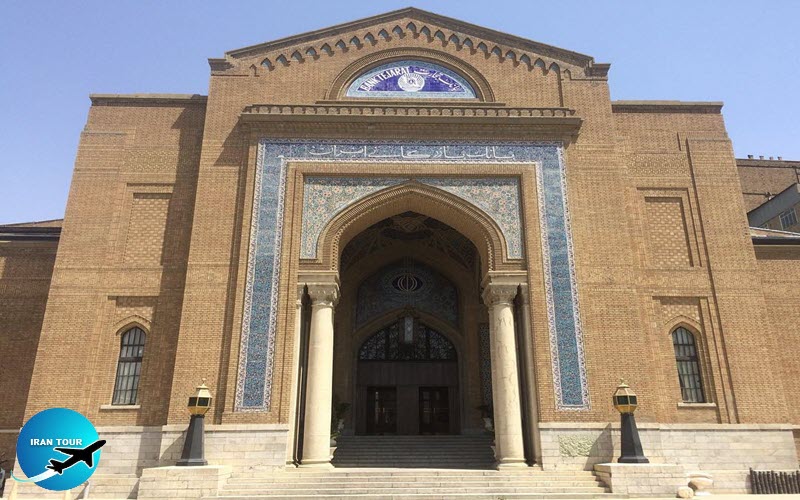 |
1-Tejarat Bank, A Historic Building in Tehran
On the east side of Imam Khomeini Sq, the first Iranian-British bank is located. This bank with its noble architecture is one of the free old, valuable, and historical monuments of Imam Khomeini sq. In the late 18th-century(1888) the New east Bank in London established the first modern bank in Iran. It named The British Bank of Iran & Middle East. The architecture of this building is a combination of Iranian and European architecture.
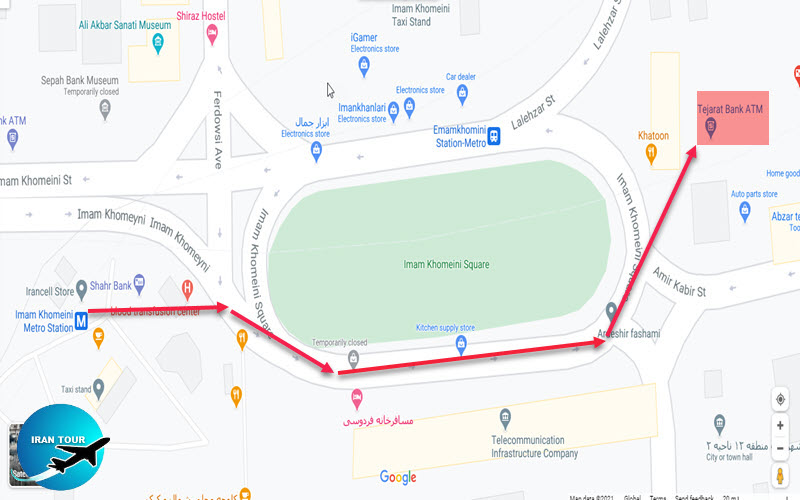 |
After visiting the bank building, back to Metro Station and continue or way to the west.
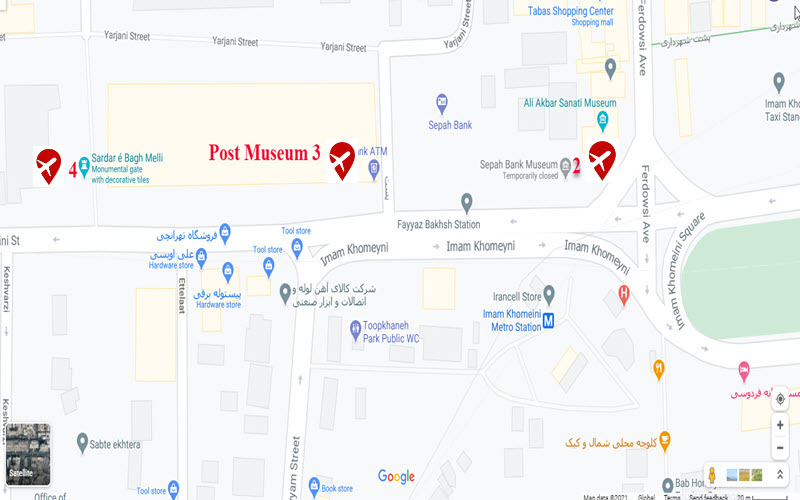 |
2-Sepah Bank - Museum: The first museum in front of the Metro station is the Sepah Coin museum. It is a free museum to make familiar with Iran money.
3- Post museum: The second museum in the vicinity of Sepah Coin museum is the Post museum. If you are passionate about communication, in the vicinity of National Garden Gate a bunch of old communication tools - news and messages in an old building are waiting for you. This free museum is one of the oldest and most beautiful government buildings, consisting of two levels comprising various lounges and rooms, and it is a suitable place for those who are interested in visiting historical and ancient relics. It should be noted that the designer and starter of this building was Markov and that it was completed by Engr. This building was transformed into the Ministry of Posts and Telegraphs and Telephones on March 10, 1996, then transformed into the Museum of Posts and Telecommunications on August 3, 1999.
4- National Garden Gate: After 300 M on the north side of the street, and on the right side of the Post museum, you can watch one of the old gates of Tehran by the name Sardar e Bagh Meli or National Garden Gate. The National Garden Gate is the only monument that has remained from a military complex founded in the Qajar period. The collection includes various military units that have been used for military exercises such as soldiers' parades - shooting exercises and other training operations. These buildings were renovated during the Qajar period and Pahlavi to new buildings such as the Ministry of Foreign Affairs - Museum - Officers Club - Other sections of the government. When you are walking in this area, the architecture of the buildings declares the history of Iran from 100 years ago.
Bāgh Melli (National Garden)
Is a name given to this building by the people. This edifice was initially built for the purpose of establishing a gate for entering the Mashq Square which was a garrison and was named as "Mashq Square portal. But the simultaneity of the first years of edifice the portal with the construction of a public garden Inside the Masha Square caused the people to give the name of "Bagh Melli portal to this building. Bagh-e Melli in which the people were mostly concerned, did not last for a long time and governmental buildings were built instead, but the people still remember the name and memory of it. The Portal Architecture is inspired by the ancient gateways of Tehran city especially "Darvaze Dowlat (Dowiat gateway that was located at the southwest of the Old Toupkahneh. Since during these years, the Cassocks division in Mashq Square was administered by the Russians, it is believed that the Russian Architecture style has also played a role in the architecture of the portal. The portal's architect was mentioned to be Ostad Jaafar Kashi who was one of the stylist architects of that era. The initial portal consisted of three entrance gateways divided into sidewalk and coach road and two guard quarters were located at both sides of the gateways. At the top of the middle gateway of the portal, there was a room that was the lookout place and a location for playing kettle drums in the popular style of that time. During the development phases of Mashq Square, the guards quarters of both sides were removed but the gateways and kettle drums playing places above them have remained the same The tile epigraphs attached to the portal contain eulogies in praise of Reza Khan Sardar Sepah, who was the army commander and diet of this edifice. A few tiles existing in this building were taken from the older building of the portal located at another place at the east of the square and some parts of the new epigraphs were also made by Ostad Hossein Kashisaz. On top of the cast-iron and exquisite gateway of the portal, the name of the artist-craftsman "Muhammad Ali Kermani" the creator of It, was written. These gateways were built in Tehran's armory that was the most important industrial center of Tehran at that time and was considered to be a demonstration of the construction industry development of that time. Bagh Melli Portal was placed on the National Heritage List on April 22, 1997, by No. 1968.
Qazaq Khaneh (Cossack's quarters) Edifice
Is the most outstanding and most ancient edifice located in the Masha Square complex? Qazag Khaneh building is formed of two parts of Qajar and Pahlavi. The Qajar's Era part of the building consists of several phases of change and transition and the last phase is the present building established in the year 1892 AD during the last years of Nasseredin Shah (one of the Qajar dynasty kings in recent. The Pahlavi part of the building consists of developing the Qajar part of the building in eastward, westward and northward directions of the old building, arranged around a central yard harmoniously. Two separate buildings are also placed inside the central yard. The Qajar part of the edifice of Qazaq Khaneh is a neoclassical and modernist construction and a combination of the Iranian and European Architectural styles. This building must be considered as the most ancient office building of Tehran in the history of this city's changes. The building faces toward a vast square in which the military ceremonies have been held. Therefore, the building architecture is extroverted and provides the residents with a panoramic view of the surrounding area. The wailer's balconies are located in the same shape at the front and back facades of an office building. The Dajar part of the device is formed in three floors consisting of the middle part and two eastward and westward wings. The middle part is built in three floors and has a wide and magnificent stairway providing easy access to the floors. In the upper floors of the building in the northern and southern parts, there are balconies built to provide the facility for visiting the military field in the ceremonies. The eastward and westward wings are built in two floors and in the ground floor, there are columned halls with large brick-made pillars and the upper floors include several rooms formed surrounding a middle corridor. Two protruding balconies with coronet-shape pillars together with half parch steeples jutted from the facade level, consolidate the architecture of the Qajar edifice of the gata change in a way that it expresses the modernist architecture style during the Qajar Era. The central three-storey building with terraces balconies and stone-made pillars at the ground floor and the coronet-shape curvature pillars at the upper floors and steeples located alternately among the uniform windows is the main axis of the design of military square illustrated in an artistic narration. The Oaza Khaneh edifice has passed three periods of functional and matrix changes. During the first period, the daar building of the Qazaq Khaneh Is held as a garrison. The second period consists of the Pahlavi Era adjuncts and change of Caza khaneh edilce into the Ministry of War and the third period consists of taking possession of the military edifice by the University of Art in the year 2001A.DY and converting this historical complex into an educational and cultural function.
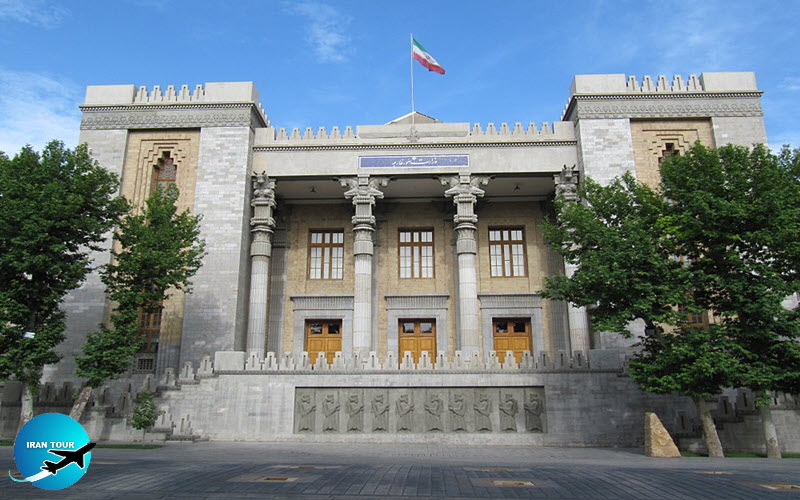 |
-Buildings around the National Garden Gate
The space of the former Mashgh(practice) square and the current national garden is surrounded by several historical, beautiful, and valuable buildings. In the past, these buildings were named after the Anglo-Iranian Oil Company, the Police Palace, the Ministry of Foreign Affairs, Barracks(art University now), the Museum of Ancient Iran, the National Library, the Real Estate Registry, the Post Office, and the Officers' Club. Most of these names have been changed, but buildings are used with different uses. Another unique feature of this historical complex is the Malek house. This historical house belongs to the Qajar period and has been turned into a museum and library.
- Malek Museum: The Malek Museum which is a free museum is an old house of the Qajar era which belonged to Haj Hossein Agha Malek. This building extended to the Pahlavi era and changed to Malek Museum. This complex is included in a Qajar house, a library, and a museum. The two parts of the building incorporate architectural elements and decorations from the Qajar and Pahlavi periods, including brickwork, tile work, plasterwork, wooden decoration, stone carvings, wood carvings, metal works, and wallpapers. This collection contains beautiful and breathtaking objects like Stamp Exhibition, Permanent Coin Exhibition, Calligraphy and Painting, decorative Arts, Picture, 19000 of different Books, Miniature, And other arts.
The last, most valuable, and attractive buildings around the National Garden is the building of the National Museum of Iran.
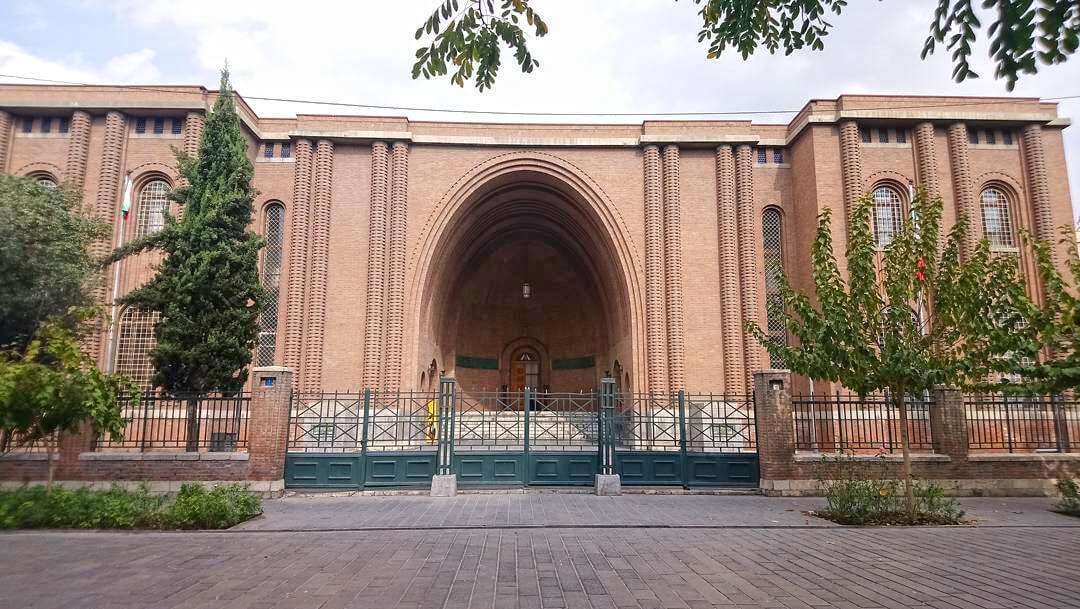 |
5-Iran National Museum: Although this modest museum is no Louvre, it is chock-full of Iran’s rich history. No visitor can afford to miss the National (Archaeological) Museum of Iran (in Imam Khomeini Ave), the country's mother museum established in 1937. If the Louvre is your first choice on arrival in Paris, this Museum is your spiritual home in Tehran, where objects unearthed during recent excavations are to be found side by side with objects representing the great periods of history and pre-history. It can be seen in one visit, but we recommend you two visits: one to the pre-historic, Achaemenian, and Sassanian finds on the first floor, and another to the Islamic objects on the second floor.
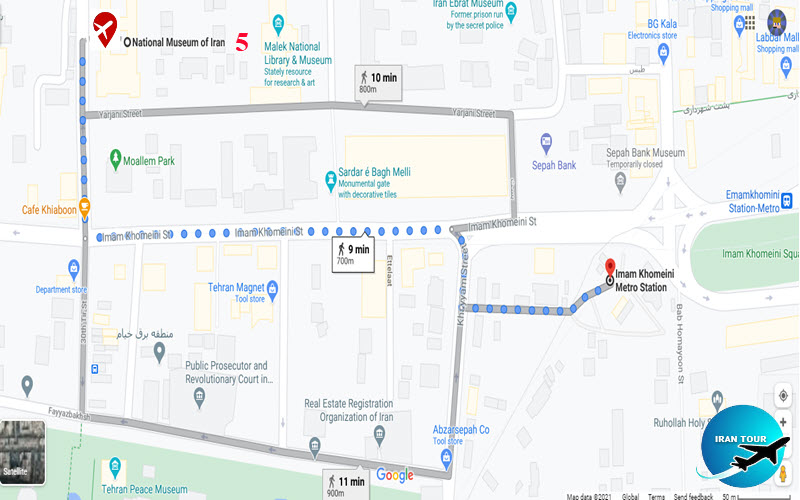 |
The building, designed and completed in 1928 by French architect André Godard. It is one of the most attractive old buildings in Tehran, blending Sassanian principles such as the grand Iwan-style entrance with art deco–style brickwork. This museum with two separate buildings(Historic & Islamic) hosts Millions of tourists annually.
After visiting Iran National Museum, we return to Imam Khomeini Square (500 meters) to identify another exciting path.
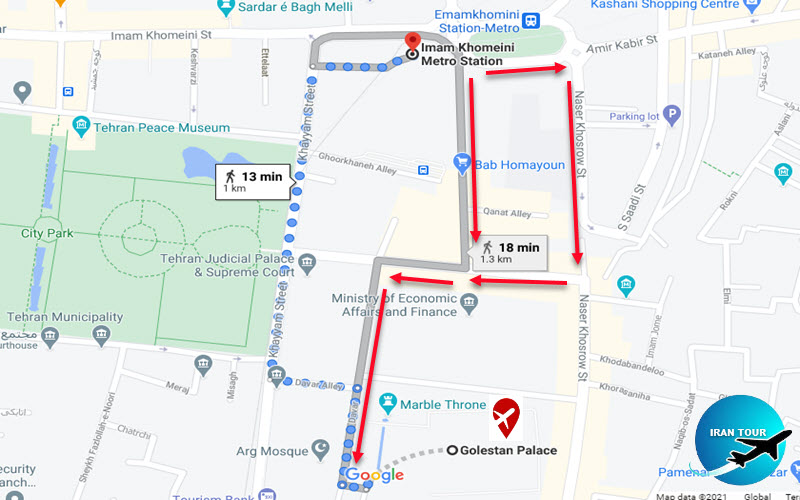 |
6- Bab Homayoon Street: If you are a street food lover, this is one of the best local places.
In the vicinity of Metro station toward the South, one of the first streets of Tehran is calling you. After the opening of Imam Khomeini Square, various streets were built around it. One of the first major streets around it was Bab Homayoun Street(a place for street food), which had been connected to the Golestan Palace complex directly. It was founded by the order of Nasser al-Din Shah, the most famous King of the Qajar Empire, this street was set up with various shops to expand economic activity. Today, this street is one of the most important centers in providing the latest and most beautiful men's clothing. You can also spend a night on the street and enjoy street food.
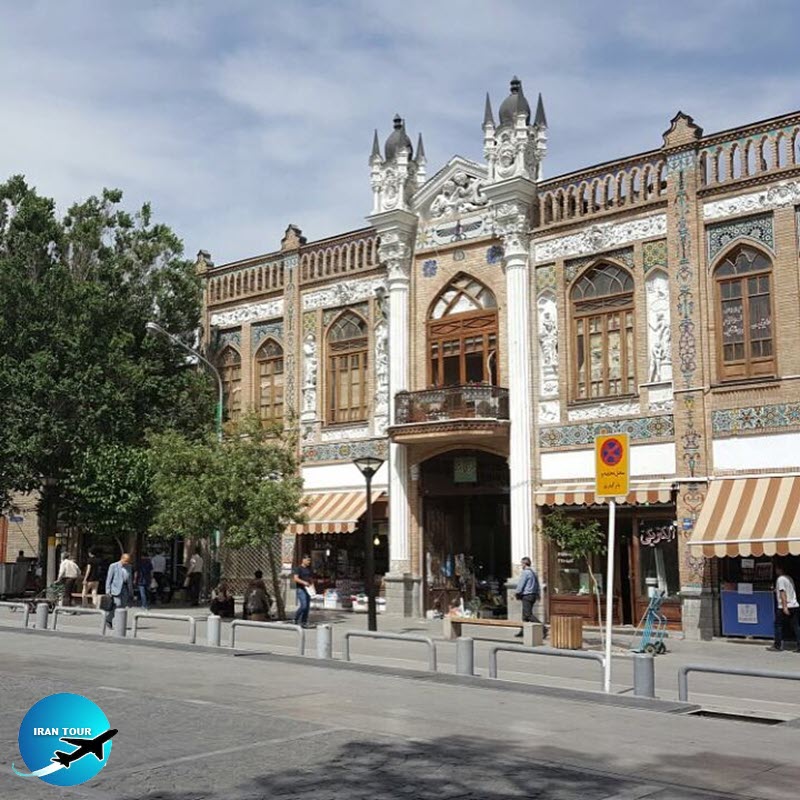 |
Continue south along Naser Khosrow St. Once was one of Tehran's grandest avenues it is lined with impressive buildings, such as Dar ul-Funun, established in 1851 as Iran's first modern university. Peek into the courtyard where there's a garden designed in the shape of the Union Jack. Further south, Naser Khosrow is pedestrianized and runs along the back of Golestan Palace. Naser Khosrow leads you to the entrance of the Grand Bazaar.
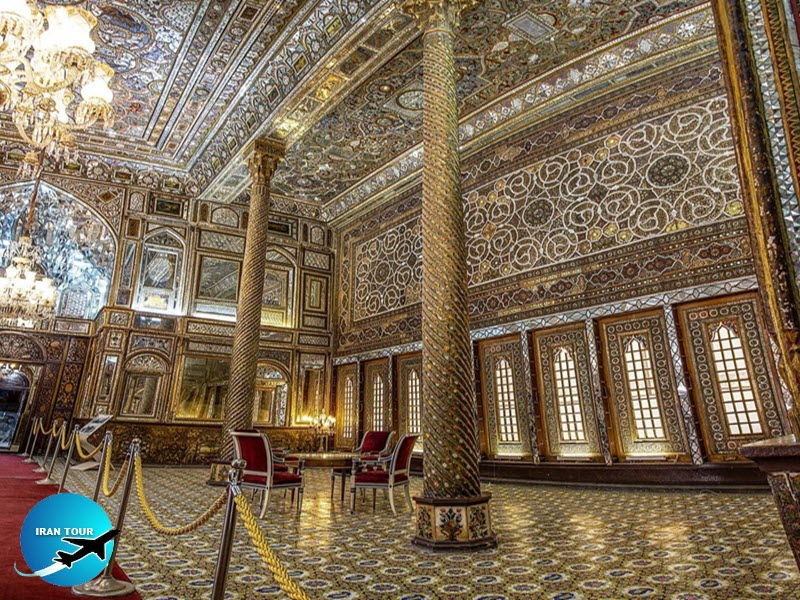 |
7- Golestan Palace: The Qajars' royal residence, the oldest substantial building in the city, and one of a group of royal buildings then enclosed within mud walls known as the Arg, the Golestan Palace, where the glories and excesses of the Qajar rulers unfold in this complex. The grand buildings are decorated with the best beautifully painted tiles and set around a picturesque garden worth visiting in its own right. This palace was not only the residence of the Qajar kings and their families but also the coronation ceremonies of two Pahlavi kings were held there.
At present, You can visit the complex includes Takht-e-Marmar (Marble Throne) terrace, Khalvat -e- Karim Khani, Talar-e Salam (Special Museum), Talare Ayeneh (Hall of Mirror), Talar-e Adj (Hall of Ivory), Talar-e Berelian (Hall of Brilliant), Emarat-e Khabgah (Dormitory), Shams-ol-Emareh (Edifice of the Sun), Badgir Building, Chador Khaneh, Talar Almas (Hall of Diamond), and Abyaz (White) Palace.
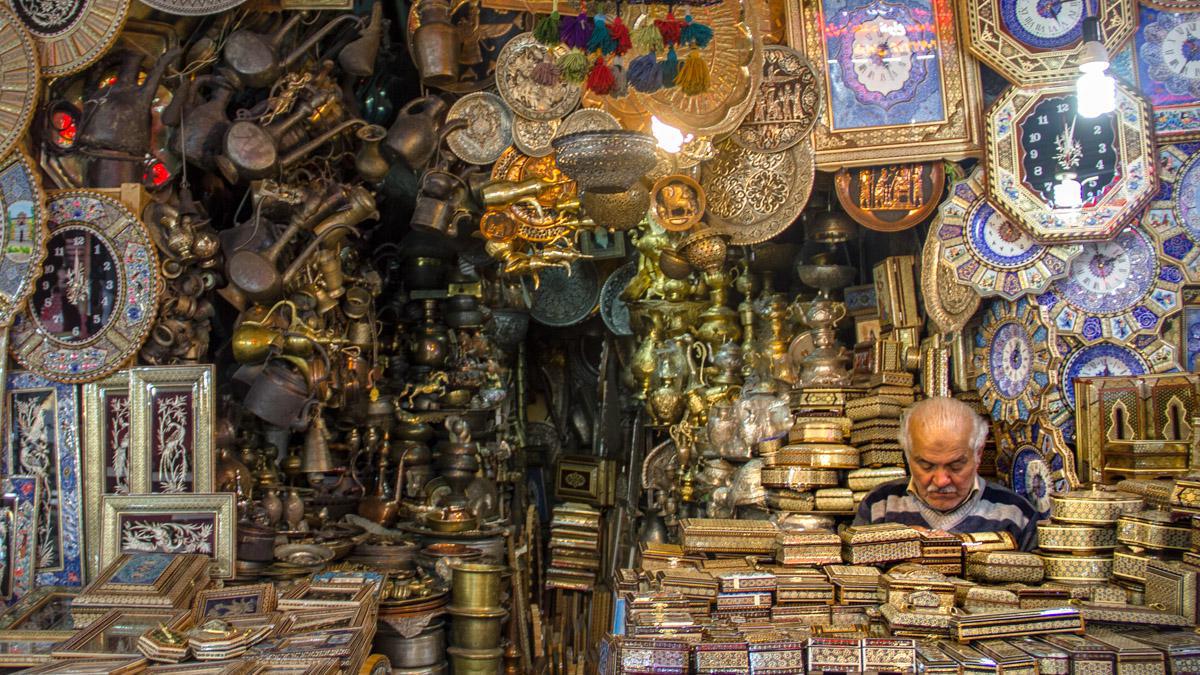 |
8- Tehran Grand Bazaar: A must-see place to visit during your Tehran tour program. The heart of Persian culture and trading, that amazes all tourists. A wide range of human-cultural and artistic factors together have created the largest economic complex in Tehran and Iran. A historical complex with more than 10 km long - thousands of colorful shops - millions of daily visitors and a collection of beautiful and impressive elements such as banks, church, fire station and several mosques, including the most important of them is the impressive Imam Khomeini Mosque.
THINGS TO DO IN TEHRAN GRAND BAZAAR
SOUVENIR SHOPPING
The best place to buy souvenirs on your trip. It might not be the cheapest, you need good negotiation skills, but you will find a collection of all parts of Iran. From Isfahani rugs to Termeh rugs, including Yazd and Shirazi ceramics. Foodies should watch out for pistachios and saffron.
LOOK AT AND AROUND
As you walk around, don't forget to look up and around. The domes and ceilings are magnificent and show the long history and art.
MEET PEOPLE AND BABY TEA
Be sure, you will invite for a cup of tea at the bazaar. While the sellers want to sell you something, they are also curious about you as a foreigner. Before you know it, you talk about politics or philosophy with people you have met. Iranians are among the friendliest people in the world.
WHERE TO EAT
You can find the best old restaurants with delicious Iranian dishes.
MOSLEM RESTAURANT
The Muslim restaurant welcomes about 5,000 visitors daily.
They serve one of the best Tahchin chicken in Tehran. It's a butter chicken with rice, saffron, and barberry. They serve huge portions and the food is absolutely delicious. The long queue outside might stop you.
KHAYYAM TRADITIONAL RESTAURANT
If you prefer a more ambient setting in Tehran's bazaar, head to the decorated traditional Khayyam restaurant. It located in a section of a 300-year-old mosque.
SHARAF OL ESLAMI
Always busy and serving large portions of rice and high carb skewers at a great price. You can find Sharaf ol Eslami close to Imam mosque.
SHAMSHIRI
For the best-grilled kebabs in Tehran's Bazaar, head to Shamshiri.
The last part of your discoveries in Tehran Bazaar is Imam Mosque or Shah Mosque (before the revolution). For easier access, it is recommended to use the path of Sabze Meydan square to the east (350 meters. This beautiful mosque with stairs to the northern courtyard of the mosque will be on your right.
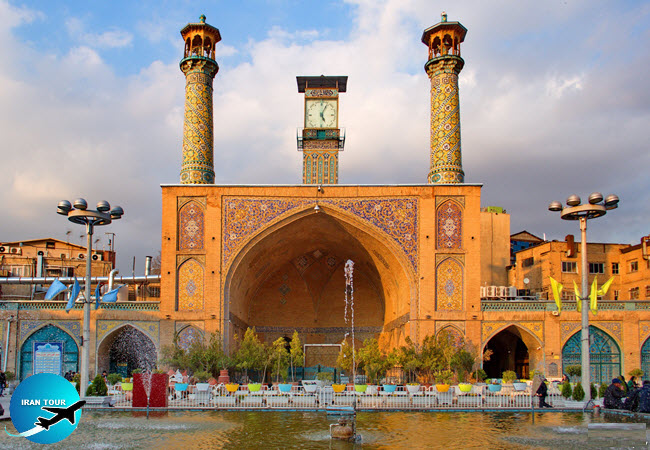 |
9-Imam Mosque: Imam Mosque (historically known as Masjid-e Shah or the Royal Mosque), the construction of which began by Fath Ali Shah Qajar in about 1809 in line with his efforts to embellish the newly founded capital, was completed in 1849. It stands at the northern entrance to the bazaar not far from the Golestan Palace. Two side entrances of the mosque lead directly into the bazaar. The southern Ivan opens onto the prayer hall. The mosque has the usual four Ivans, on each of the four sides of a single-story arcaded court, decorated with early 19th-century haft range tiles. The turquoise and white dome of the sanctuary chamber beyond the south Ivan is crowned by a small gilded cupola seen here peeping over the Ivan. At the pool in the center of the courtyard - a feature of nearly all mosques the Moslems performs their ritual ablutions before each prayer.
- Details
- Category: Tehran Tourism